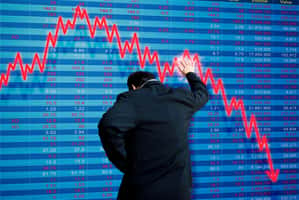Last week the market briefly sold off in minutes, following news that the Biden administration was proposing doubling the long-term capital gains rate for those making over $1 million.
The market recovered quickly, and soon was making new record highs again.
However, with the S&P 500, and other major indexes, off to a roaring start in 2021, many investors are worried that valuations have become extreme.

The nature of overvalued markets and corrections is that it doesn’t take much to flip the market from greed to fear.

With the S&P 500 now on a heck of a winning streak, up almost 100% since December 2018. The tech-heavy Nasdaq is up 133% in that time.
So let’s take a look at what investors need to know about how big of a threat rising taxes might pose to a market that’s priced for perfection.
Tax Proposals Aren’t As Scary As They Seem
First, it’s important to know what the proposed tax hikes actually are.
- Biden administration proposes raising the corporate rate from 21% to 28% for 15 years
- the income tax rate on those making over $400K per year would rise from 37% to 39.6%
- the long-term capital gains rate would rise from 23.6% to 43.6% for those making over $1 million per year
- the step-up provision would be eliminated
0.3% of Americans make over $1 million per year, so for almost everyone our long-term capital gains rates would be unaffected.
The corporate rate rising to 28% would indeed reduce earnings considerably however, Goldman Sachs has been using a 25% corporate rate as its base case for almost two years now.
Joe Manchin, the kingmaker conservative Democratic Senator from West Virginia has said that he’s comfortable with 25% but not 28%.
The size of the proposed infrastructure bill, $2.3 trillion over eight years, naturally means this is going to be complicated and involve many months of negotiations.
Manchin has thus far made some rather contradictory statements regarding what he will and will not vote for.
- up to a $4 trillion bill but it must be paid for 100% by tax increases
- Manchin says he refuses to allow this bill to not include at least 10 GOP Senators (no reconciliation)
- GOP has said that large tax hikes are their red line in the sand
It appears that both sides want an infrastructure bill and Manchin most of all. The $570 billion GOP counter-proposal is expected to be a starting point for negotiations.
Republican Lindsey Graham has said that some in his caucus have indicated that up to $900 billion is what Republicans might be willing to vote for. Of course, that depends on what the tax increases actually look like.
Why You Shouldn’t Panic With Your Portfolio
Let’s start with the corporate tax hike proposal, which would have the biggest direct impact on earnings.
A 7% headline increase in taxes might seem pretty scary. It’s not.
No less than Jeff Bezos, outgoing CEO of Amazon has said he’s in favor of the full $2.3 trillion bill, including the 28% corporate rate.
Doesn’t Amazon stand to face a big tax bill if the corporate rate increases?
Amazon Tax Consensus Forecast
| Year | Net Income | Tax Costs | Tax Rate |
| 2020 | $21,331 | $2,863 | 13.42% |
| 2021 | $24,829 | $5,027 | 20.25% |
| 2022 | $35,055 | $7,066 | 20.16% |
| 2023 | $48,534 | $9,602 | 19.78% |
| 2024 | $64,499 | $10,079 | 15.63% |
| 2025 | $83,551 | $13,764 | 16.47% |
| 2026 | $114,235 | $18,719 | 16.39% |
(Source: FactSet Research Terminal)
Indeed it does. Amazon’s expected taxes are set to soar, as it becomes the most profitable company in world history in 2026.
But notice something. The corporate rate is 21% today, and yet Amazon’s consensus tax bill never even hit that. In fact, in 2026, when it’s estimated that Bezos’s empire will earn $114 billion, the consensus tax rate is 16%, not 21%.
The reason for that is the actual tax rate of US companies depends on many things, such as growth spending, much of which is immediately deductible.
In 2026 Amazon is expected to spend $122 billion in R&D and CapEx. Which is expected to save it almost $6 billion that year under the current tax code.
JPMorgan’s blue-chip economists have crunched the numbers about how much S&P earnings are likely to actually decline if the corporate tax rate goes up 7%, to 28%.
“While the tax increase proposal remains up in the air, JPMorgan estimated that if it went into effect, the S&P 500 would see a 4% decline in earnings per share.” – Business Insider
A 7% headline increase in the corporate tax rate, is expected to reduce EPS by 4%. Granted, that would likely be a permanent decrease in earnings, however, it’s not expected to cause the stock market to fall out of bed.
In fact, JPMorgan estimates that IF the rate were increased to 28%, the S&P 500 would plunge… all of about 5%. In other words, a historically normal, healthy, and mild pullback.
“JPMorgan also outlined four reasons why S&P 500 companies are well-positioned to absorb the potential corporate tax rate increase.
A robust economic and earnings recovery, elevated corporate cash balances, a partial offset from net operating losses of $290 billion, and a boost in aggregate demand stemming from increased government spending should help insulate companies from the tax hike.” – Business Insider
And as JPMorgan points out, US companies are currently sitting on record cash piles, earnings are booming, and the $2.3 trillion bill could drive stronger economic growth through 2030 according to Bank of America and Moody’s.
But what about the potential doubling of the capital gains tax rate? Might that not cause some major selling in the next few weeks or months?
In part 2 of this series, we’ll see how big of a threat that proposal really is, and what prudent long-term investors should do to protect their nest eggs.
SPY shares were trading at $418.32 per share on Thursday morning, up $0.92 (+0.22%). Year-to-date, SPY has gained 12.25%, versus a % rise in the benchmark S&P 500 index during the same period.
About the Author: Adam Galas

Adam has spent years as a writer for The Motley Fool, Simply Safe Dividends, Seeking Alpha, and Dividend Sensei. His goal is to help people learn how to harness the power of dividend growth investing. Learn more about Adam’s background, along with links to his most recent articles. More...
More Resources for the Stocks in this Article
| Ticker | POWR Rating | Industry Rank | Rank in Industry |
| SPY | Get Rating | Get Rating | Get Rating |
| AMZN | Get Rating | Get Rating | Get Rating |





